The Looming Threat of "Generation Z"
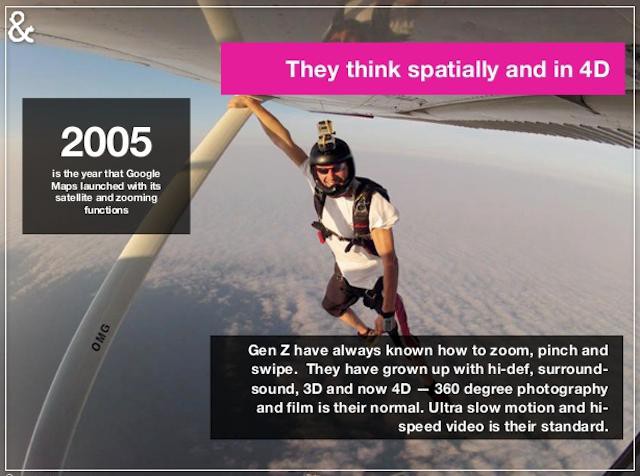
“Here Comes Generation Z,” cheers a headline on Bloomberg View. “If, like me, you’ve been looking for a primer to explain Generation Z, the one that follows the ‘Y’ millennials,” the writer says, “take a look at this 56-slide presentation by Sparks & Honey, a hard-to-pin-down organization that’s part marketing agency and part think tank.”

This presentation is not a primer. Nor is it a marketing deck, though that is its form. It is a stunning work of speculative fiction about a future that must be avoided at all costs. It imagines a generation defined exclusively in opposition to the ill-defined one that came before. Its incoherence, like the incoherence of its subjects, it what gives it such paralyzing power.
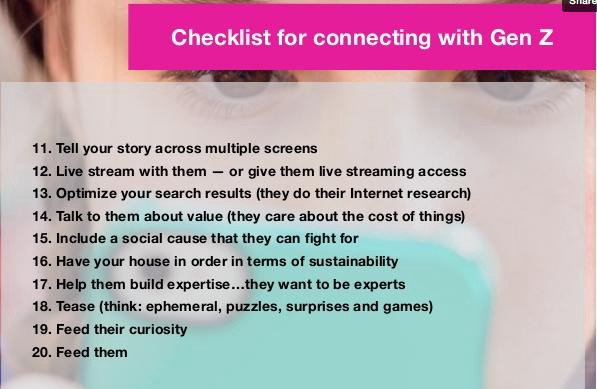
It is a Childhood’s End for our time. It is a portrait of a ruined generation, rendered from the point of view of America’s worst industry.
“Their social circles are global,” the marketers warn.
“They are the biggest foodies,” the marketers say.
“Feed them,” the marketers demand.
Could this be a joke, maybe a little? It must be, right? It doesn’t matter: In marketing, jokes never stay jokes for long.
New York City, June 18, 2014

★★★★ Hot wind hissed through the leaves on the plaza. The rails of on an open-topped sightseeing bus gave off a blinding flash, and so did the subway steps on the way back up. Up in the darkness of the tree crown in the churchyard by Prince Street, someone in a cherry picker was at work with pole saws. Severed branches were being passed up and over the high brick wall and into a chipper. The restaurant windows were closed, the blinds lowered. Short, clear shadows raised decorative conical brickwork to a mammary roundness. Up on the office roof, the black woven plastic of the desk chairs was hot; slumping into one gradually baked the air-conditioning chill out of the depths of the lower back. A mourning dove walked around the corner of a planter, cocked a liquid eye, and walked right back. A few minutes later, it or another returned, chin fluttering and legs vivid red in the sun. The mobile phone was hot to the touch. Still, the roof was better than being in the freezing indoors. By rush hour, the heat had subsided in the shade, though the glare still overpowered the eyes. The two-year-old, riding on shoulders to the store, was on the lookout for motorcycles — motorbikes, scooters, anything — and finding plenty.
The Rise and Fall of Vincent Winfield
by Brendan O’Connor
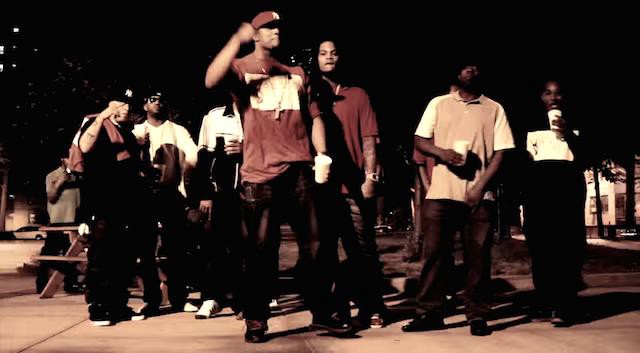
Two weeks ago, at the Eastern District Court of New York, federal prosecutors played a video of the rapper and alleged drug kingpin Ronald Herron, better known as Ra Diggs, driving around Boerum Hill, monologuing about his life and his environment. “This is not my ‘hood like I’m from here. This is My Hood,” Herron says, looking out the window as he drives. Herron throws his whole weight behind the last two words as the tall, brick buildings of the Gowanus Houses flash by in the background. “I am surveying my terrain.”
The video was filmed in the fall of 2008 by a man named Vincent Winfield. Also known as Dip or Dipset, he was, at the time, Herron’s “pistol” — not an enforcer exactly, not muscle, but something else: He carried a gun for Herron and travelled with him almost everywhere. “He was my friend,” Winfield testified. “He was my Big Homie.” Now Winfield, who has plead guilty to and is awaiting sentencing for two counts of attempted murder, is a cooperating witness in the Attorney General’s case against Herron, who is charged with, amongst other things, several counts of racketeering, murder, and narcotics trafficking. The government prosecutor stopped and started the video intermittently to ask Winfield questions. The song Herron was rapping, Winfield told us, is one of Herron’s own, called “Rat Hunter.” The prosecutor then asked Winfield what a rat is. “Cooperators. Snitches. Whatever you wanna call them,” Winfield said. The prosecutor pushed play again and Herron addresses the camera: “Anyone who cooperates deserves to be exterminated.”
Vincent Winfield knew who Ronald Herron was well before they met. Five years Herron’s junior, Winfield started selling crack in 1999; he was thirteen year old, and his supplier was supplied by Herron. It was another seven years, however, before Winfield came to know and work for Herron directly.
In 2003, Vincent Winfield was arrested and convicted of armed robbery. He’d been a Blood since he started dealing, and after two stints in the Bronx’s notorious Spofford Detention Center — Winfield got picked up the first time for throwing bricks off the Cross Bronx Expressway — he’d acquired a reputation for violence. During the course of a transfer, Winfield testified that he found himself in an argument with another inmate. They nearly came to blows before guards stepped in and gave the men a choice: they could go back to their bunks, or they could fight. If they chose to fight, neither man would receive medical attention. While the guards watched, Winfield beat the other inmate so badly that he couldn’t work for several days, and Winfield took over his duties as a porter. Herron was being kept in a larger, communal area known as “The Fishbowl” for its plexiglass walls. Winfield described walking down a row of cells, at the end of which was The Fishbowl, and seeing Herron, five years into a six-year prison term, sitting against the wall, watching everything around him.
Herron had been indicted in 2001 for the June 16th murder of Frederick Brooks, a drug dealer who had been selling on Herron’s turf. On the day of Frederick Brooks’ death, two witnesses made recorded statements to the Assistant District Attorney that they had seen Herron shoot Brooks in the head. The witnesses — who had identified Herron in a police lineup and again during testimony before a grand jury — recanted during the trial, and Herron was acquitted. In July 2007, Herron was released from prison into what Winfield described as an “open market” — all of the major players in the drug trade at the Gowanus Houses had been locked up. He and Winfield continued to communicate, exchanging letters and talking over the phone. “Normal conversations, nothing incriminating,” Winfield testified. “We knew the phone was wired.”

By the time Winfield was released, a year later, Herron had consolidated control of the three buildings in the Gowanus Houses historically associated with the drug business: 198 Bond; 423 Baltic; and 417 Baltic.* “Not every building is a drug building,” Winfield said. (“Think of drug dealing like any other retail business,” Assistant U.S. Attorney Sam Nitze had explained, helpfully, during opening arguments. “Location is important.”) Consolidating control of the Gowanus Houses, Winfield testified, wasn’t hard: Herron’s reputation preceded him. “He was violent and he beat a body. People just fell in line.” Winfield described. (“To beat a body” is to be charged with a murder that you did, in fact, commit, and to be acquitted of that crime.) “He killed somebody and got away with it,” Winfield said. “The average person thinks, ‘I’m not gonna mess with him.” Herron gave everyone in Gowanus an ultimatum, Winfield said. “Either you cop from Ra or you sell for Ra.” And they did.
Herron told his friend not to rush back out onto the street. “Things were gonna fall into place sooner rather than later,” Herron told Winfield. “I would find a place to fit in at.” Soon enough Winfield was slinging from the lobby of 198 Bond, though by this point he was bored with the day-to-day routine of selling crack. Standing in the same place every day, waiting for junkies: “It wasn’t for me,” Winfield said. Herron recognized Winfield’s dissatisfaction. “We gotta find something for you to do,” he told the younger man. So it was that Winfield became Herron’s pistol. Others in Herron’s organization had known him longer, but no one, not even Herron’s right-hand man Jorge Mejia (a.k.a. “Moose,” or “Mussolini”) spent as much time with Herron as Winfield: “Not like I was,” Winfield testified. “I was with him all the time.”
In September of 2008 Herron, Winfield, and the rest of the Gowanus-based Murderous Mad Dogs endeavored to expand their operation from the Gowanus Houses to another housing project called Wyckoff Gardens. Wyckoff Gardens are only one avenue block east of the Gowanus Houses but remained culturally distinct. (The two housing projects, not a dozen blocks north of the new Gowanus Whole Foods, are flanked on the west by the aggressively bourgeois Cobble Hill and Carroll Gardens; the Barclays Center sits three avenues east and a couple blocks north.) “Gowanus and Wyckoff were known for years to beef,” Winfield said. Herron, moreover, did not command nearly the same amount of respect in Wyckoff as he did in Gowanus. Still, Winfield, Mejia, and Shondell Walker (a.k.a. “M-Dot”) started supplying a few drug dealers in Wyckoff, including two by the names of Macho and Manny. As for anyone who didn’t take the Mad Dogs’ supply, Winfield testified that Herron told his men, “Rob ’em the first time, shoot ’em the second time.”
Herron and his crew continued to expand into Wyckoff Gardens over the fall of 2008; on November 9th, however — the day after Winfield’s birthday — Mejia, Herron’s second-in-command, was shot by two Wyckoff dealers. Mejia told Herron that he had been shot by Macho and Moose — the two dealers Herron had begun supplying during his initial foray into Wyckoff. Macho and Moose, Winfield testified, were acting under orders from another player in Wyckoff Gardens, Victor Zapata.
With Moose laid up in the hospital, Herron and Winfield began patrolling the Gowanus Houses and Wyckoff Gardens in Herron’s truck — in the back of which was a Modell’s bag containing hoodies, masks, and gloves — looking for the men who’d shot their comrade. The daily routine also allowed Herron to look in on his dealers, making sure everyone was where they were supposed to be. It was during these rides that Winfield began filming for Herron. “Ra wanted to film it to put on his Internet TV shit he got going on,” Winfield testified. The point was promotion: “Him, his brand, and his music.”
The videos are posted on YouTube under the channel Ra Diggs TV; the entire series is called “Project Music.” The videos screened by the prosecution last week in Brooklyn have been taken down, but many still remain. In the very first video, “Project Music #1 (Part 1),” Herron stands outside one of his buildings in the Gowanus Houses handing out black t-shirts emblazoned with the words PROJECT MUSIC in large, white block letters. “It’s the music. It’s a movement,” Herron tells the viewer. “I ain’t got to pull out no guns on camera to show you this is real.” One of Herron’s songs plays in the background, and from the bench behind me in the courtroom I can hear someone behind me rapping along under his breath. In the video, a woman approaches Herron as he jokes with JoJo, his lead dealer in this particular building. She is an addict, Winfield testified. She is asking Herron for a favor; she’s three dollars short. Herron looks uncomfortable, unaccustomed to being approached by his clientele directly. They’ll figure something out, Herron tells the woman, never looking her directly in the eye.

Winfield was arrested again a few months later on December 21, 2008. He and Herron were stopped by police while driving outside the Gowanus Houses; Winfield got out of the car, ran, and slipped on the snow and ice. He had two guns on him: one fell out of his waistband while he was running; he was caught and arrested with the other. Herron, meanwhile, somehow managed to elude the police. Winfield plead guilty to the gun charges and was sentenced to fifty-seven months at the federal level and four years at the state level, served concurrently.
Winfield’s sentence would have been up last fall, but he had continued to get into trouble on the inside, getting into fights and selling drugs, and time kept getting added to his sentence. In 2010, he contacted the Federal Marshal Service and made a deal with the Office of the Attorney General, who was in the midst of an investigation into Herron. (The AG’s office did not respond to a request for comment.) Winfield copped to all of the federal charges against him and agreed to testify in the AG’s case against Herron. If he held up his end of the bargain (“Tell the truth and stay out of trouble”) the AG would write the judge in his case a letter known as a 5-K-1, recommending leniency in his sentencing. However, Winfield has continued to get into fights with other inmates — one would imagine it is difficult not to get into fights, at least to defend oneself, once word gets out that you are a cooperating witness — and was also caught smuggling weed. (At the time, Winfield was being kept at the Queens Detention Facility, which he called “GEO,” in reference to The GEO Group — private contractors who took over control of the prison from the Marshals in 2005.) Winfield is facing fifteen-years-to-life in prison in addition to the time that’s already been added to his sentence (as a result of crimes committed while in prison).
Herron’s music career took off while Winfield was in prison, recording songs and videos with a variety of New York City artists and in particular with Murder Team, a rap crew that includes Herron, Waka Flocka Flame, and a third man by the name of Uncle Murda. All three feature prominently on Flocka’s song “Live By The Gun, Die By The Gun,” the video for which the government showed during Winfield’s testimony — despite Winfield having been in prison at the time of its production.
The video is filmed and set at the Gowanus Houses and features all three members of the Murder Team as well as members of Herron’s crew. In his verse Herron (or, more specifically, identifies himself as a Murderous Mad Dog, flashes gang signs, and raps, “Nigga shot me five times / two days later the nigga died.” This, the government argued, is a direct reference to an incident in 2000 when Herron was shot in the legs five times. Two days later, Herron still in the hospital, the shooter was killed by Herron’s cousins. “Put in my own work but niggas’ll kill for me,” Herron raps. A few years later, on “Slow Down Remix,” a track he did with Uncle Murda, Herron raps, “I don’t respect a shooter who shoot me in the legs / ’cause two days later the little nigga was dead / see if he was smart he woulda shot me in the head / ’cause I could get you shot from my hospital bed.”
The fact that Herron’s rap career only began once he left prison is central to his case. “Mr. Herron became a different person while in prison,” James Neuman, one of Herron’s lawyers, argued in his opening statement. “The experience made him stronger. He began studying, reading voraciously.” He wanted to make a positive contribution to his community, “to give a voice to people in the projects where he grew up,” Neuman said, and he devoted himself to his art. To that end, Herron developed the persona “’Ra Diggs,” one that was grounded in real events — though not all of what he referenced, the defense naturally argues, is true. Ra Diggs’ music “is not meant to be autobiographical fact, and not meant to be warnings to the public.” Uncle Murda contributed to this narrative outside of the courtroom as best he could. “My boy Ra was focused on his music,” he told VladTV in September. “We was moving in a positive direction.”

At issue is the question of truth and authenticity in art, which is especially fraught when talking about a genre of music as lyrically violent as gangsta rap. “If you know you actually did something, that was a crime, there’s a way you gotta say things, there’s a way you say it so it don’t directly, if you killed a motherfucker before with a four-fifth, in your rhyme you kill him with a nine. You don’t give the details so direct,” Uncle Murda postulates. “You can give the story but you gotta switch it up a little bit.”
Before the trial even began, the defense argued that these videos — both the music videos and the Ra Diggs TV videos — should be considered inadmissible as evidence, that they are protected speech under the First Amendment, irrelevant to the substance of the case, and would be unduly prejudicial for a jury who might not be familiar with the nuances of the genre. The government had introduced the videos as evidence “to establish the existence, structure, purpose, methods, and means of the charged Ronald Herron Enterprise; the defendant’s role as leader of the enterprise; the relationships of trust among the defendant and his co-conspirators, including several of the government’s cooperating witnesses; the defendant’s unlawful possession and use of firearms; and specific crimes committed by the defendant to further the goals of the enterprise and to maintain his position as its leader.” The videos are not part of a criminal enterprise, the defense counsel argued, but rather “commentary on urban crime and violence, drug wars, and the utter lack of hope in the inner city.” To that end the defense called Dr. James Peterson, Director of Africana Studies and Associate Professor of English at Lehigh University. “People will boast and brag about stuff,” Peterson testified. “If you appear to be authentic, that is what’s important.” In “Project Music #1 (Part 2),” Herron drives around Gowanus Houses with Winfield. “This ain’t no DVD shit,” he tells the camera. “I’m ready for war on all fronts. This ain’t no manufactured shit.”
Winfield’s testimony, meanwhile, seems just as brutal a commentary on the “utter lack of hope in the inner city” as anything else. He told, at one point, of a piece of advice Herron gave him after he’d failed to kill someone who’d threatened his life: Winfield shot the other man in the leg, put his gun to his head and pulled the trigger but was out of bullets. Winfield heard police sirens approaching and escaped. “More than one shot draws attention,” Herron told Winfield later. The two were sitting on a bench in the Gowanus Houses; Herron pulled out a .40 caliber pistol and fired, once, it into the ground. People stopped and looked around before going about their business. “You should only need one,” Herron concluded.
* Ronald Herron grew up in 423 Baltic. There, in 1994, when he was fourteen years old, he watched a rookie cop accidentally shoot and kill one of his friends while they were playing on the roof. The story made it to A1 of the New York Times.
Brendan O’Connor is a reporter in New York.
A Poem By Kristina Ten
by Mark Bibbins, Editor
Lazy
I have too many bones in my feet and
I have too many teeth in my mouth and
I put too much clout in follower count
and you, my belly my lemon my grove
This house is split by computer cables
This house has tables that drop every plate
This house is thigh-chafed sun-spoilt and Christ-cradled
and you, my wet mozzarella my love
And you, sugar pill pilled sweater sweet jam
And you, my jelly meat suckled and shorn
And you, my kill and my kill and my kill and my
City’s dumpling makers all went on strike
My city is spite gold brass Stoli commercials
My city is sure-footed falling uphill
and you, my wall stud my knock knock my screw
If you cannot be honest at least burn the truth
If you cannot be ruthless at least admit that
This star will one day throw us clean off
This star coughs through Czech words it would mispronounce
This star is bounced checks rising boats blown raspberries
and you, my shower curtain my mildew
I will braid the veins in your translucent wings
I will sell your ivory on Amazon Prime
I will watch you spread lotion across your new legs
I will beg it will rhyme I will beg I will beg I will
Call you my house and my city and star
When you cannot be human just be what you are
Kristina Ten is a dog person and a people person, in that order. Her work has appeared in Word Riot, The Literateur, Pantheon Magazine, Quiet Lightning’s sparkle + blink, and SP CE’s LOVEbook. She lives in San Francisco.
You will find more poems here. You may contact the editor at poems@theawl.com.
The One True Comment Section
But what if we could build a commenting system that gives commenters a real sense of ownership? What if readers could manage their online identity and contributions across news sites under a single sign-in? What if they could contribute pictures, links, even their own stories? What if they could track discussions and form friendships with one another? Wouldn’t that system build a sense of community and lead to self-policing and civility?
“But what if” seems to be the impetus behind the Knight Foundation’s $4 million grant to a joint New York Times, Washington Post and Mozilla Foundation project to fix, save, or salvage internet commenting. What’s missing from this proposal is the uncomfortable fact that comments have already been saved; in fact, in the power struggle between commenters and publishers, commenters are easily winning. It’s just a matter of perspective!
The online publishing narrative of the last few years, crudely, is this: Social networks are increasingly where people find things to read; people use social networks most often on their phones. It follows, then, that an increasing number — on some sites, a majority — of readers are coming to articles through comments, which command them to click on or tap all manner of internet objects, including but not limited to acts of journalism. Reading news on Facebook is like reading the old internet upside down and inside out; it’s sort of like an infinite scrolling front page composed exclusively of reader comments, which are responsible for leading you, backwards, to the articles they reference. The lunatics run things now — they write the first headlines. They also happen to be your friends.
This means that publishers are not really in a position to solve the problem of comments — it’s the commenters deciding, day in and day out and with no sense of duty or preciousness, what is to be done with news. (It is to be ignored, mostly.) The comments this project refers to, the ones it’s trying to save, are comments in an older sense; words tacked onto the side or bottom of stories written by professionals for very popular websites, written for everybody and nobody at once.

Anyway, it’s very nice of the Knight Foundation to take ownership of the Comment Problem for a couple years, giving everyone else the space to think about literally anything else. Not even God knows what the internet will look like by then.
Marina Abramović's Incidental Podcast
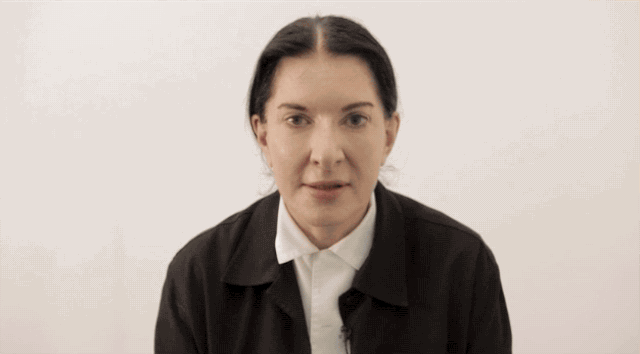
We are now on day eight of Marina Abramović’s 512 Hours, an art project which will last just over two months:
Creating the simplest of environments in the Gallery spaces, Abramović’s only materials will be herself, the audience and a selection of props that she may or may not use. On arrival, visitors will both literally and metaphorically leave their baggage behind in order to enter the exhibition: bags, jackets, electronic equipment, watches and cameras may not accompany them.
Most of us won’t make it to London to see this, and that’s fine: We have something better! The daily video diaries, which Abramović delivers straight into the camera with the severity of a Marina Abramović, the lidded weariness of a Marina Abramović, and the boundless endurance of a Marina Abramović. They’re fantastic — sometimes she sounds like an artist in her element, other times like a peeved teacher whose students wouldn’t listen all afternoon — and you can watch them all here.
How did yesterday go, for example, in the big gallery full of nervous humans?
The line of people is there already formed. And then, they’re coming in, and it’s always so cold in the morning, and their hands are so freezing, and they’re kind of shy, and they don’t know what they’re expecting inside. And the mornings are so short, and somehow, fast. But then the day rolls, and eight hours — when it’s finished, fifteen to six, I’m standing at the door, and now it’s the time for goodbyes. And these goodbyes are so wonderful; their hands so warm, and they’re looking straight in your eyes. And they’re shiny.
Enjoy your new summer morning ritual.
From the Annals of Narrishkeit
by Noah Kulwin
Covering the Yiddish beat at the New York Times is no easy task, as everywhere a New York Times reporter walks there’s something Yiddish happening.
- “A Yiddish Revival, With New York Leading the Way,” October 17, 2007
- “A Gentile Who Lives for Yiddish,” January 27, 2012
- “Some Say the Spelling of a Winning Word Just Wasn’t Kosher,” May 31, 2013
- “Passing the Time Until He Arrives: ‘Waiting for Godot,’ Translated Into Yiddish,” October 8, 2013
And yet, some alarming news from the court system:
The [mistrial] decision came after a week and a half of testimony that included reports of cash-stuffed envelopes delivered as bribes, boozy visits to strip clubs and a scheme that teamed a developer desperate to reduce his own likely prison sentence with an undercover federal agent known as Raj.
And the proceedings fell apart because of Yiddish.
…
[P]rosecutors had failed to turn over promptly to the defense more than 70 hours of wiretapped conversations, about a third of them in Yiddish, and translating and digesting them would require jurors to serve longer than some could manage.
The Yiddish revival: bupkis?
Noah Kulwin is The Awl’s summer intern.
What Kind of Idiot Will Your Next Phone Take You For?
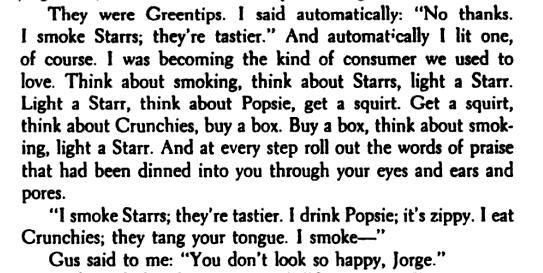
Amazon has announced a new phone called the “Fire,” and it does all the things that other phones do: calls, texts, photos, apps. There is also a physical button that activates a service called “Firefly,” which allows you to:
Recognize household items, books, DVDs, CDs, video games, and more. Access product details, add items to your Wish List, or order on Amazon straight from your Fire phone.
A ʙᴜʏ button, but for everything! A direct, interference-free line from your worst impulses to your credit card. The world is Amazon’s showroom, and you are its tired, confused customer, wandering the aisles endlessly in search of an exit that no longer exists.
Excerpt from Frederik Pohl and Cyril M. Kornbluth’s The Space Merchants, 1952
